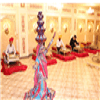Dip into the traditions of Rajasthan and experience the flavors of the north western state
The traditions of Rajasthan have continued to amaze the world. With the fusion of colors, eloquent dances, delicious food and oodles of charm fused into one, these traditions are revered by one and all. The multihued state has provided a lot of topics of discussion for people, right from the traditions to the dance costumes, to the succulent recipes; you name it and they have it. The rolling sand dunes of the Thar desert, the ancient forts and the never ending sensational culture calls out to all the travel aficionados from all over the world.
With so many festivities pervading the cultural diversity of the state’s rich culture, it becomes important to explore the roots and the history of the traditions, so that one can truly grasp the relevance bestowed through the years.
Here is a peek into the culture which explains the festivities, as they evolved through the years.
- Gangaur Festival: Spread over a period of 16 days, the Gangaur Festival caters to all the newly married women in Rajasthan. During the celebrations of this festival, the newly wedded women frequent their parents’ houses and celebrate the festival with joy and enthusiasm. Women commonly pray to Gauri, wife of Lord Shiva, as they celebrate their bountiful seasonal crop harvests. The Gangaur Festival is often said to strengthen the bond between the family members, as everyone comes together to dance and make merry, as they celebrate the onset of the spring season. Being a typical Rajasthani festival, the local people celebrate it with a lot of rigour and gusto.
- Teej: As the torrential rains bless the parched soil of the Rajasthani deserts, people come together to celebrate the festival of swings, which is also known as the Teej festival. As the fragrance of wet soil spreads through the air, the local people hang their swings from the tree branches and swing to and fro, giving wings to their imagination. The Teej Festival marks the onset of the monsoons, and it is the time for the people to worship Goddess Parvati and Lord Shiva for their blessings. People carry out elaborate parades for two days in the city of Jaipur, in accordance with the traditions of the festival. The festival often brings a lot of happiness to the women folk, as they take long vacations from their household chores and bond with other women of the villages and towns. Truly a festival which delights every man, woman and child.
What makes the Rajasthani culture so vivid and vivacious?
- Kurta and dhoti: Probably, this is the tip of the traditional attire. An ideal set of clothes for the working class of Rajasthan, the kurta and dhoti have evolved over the years. From being customary attire for the working men to becoming a fashion statement for the elite class, the dhoti kurta have come a long way over the years.
- Safa: Often regarded as the turban, the safa is way beyond the various layers of the cloth it is made of. While the safa is broadly to depict the tradition of the state, it also saves the people from the scorching sun and the harsh summer winds. Specifically speaking, there is no better helmet than the safa for the Rajasthani men.
- Ghagra choli: If one misses out on the Ghagra choli, it would be like disrespecting the traditional attire of Rajasthan. At present, the village women are predominantly seen wearing these clothes. However, like the dhoti kurta, even the Ghagra choli has become famous all over India, simply because of its vibrant design, colors, and style of exuberance.
Every bit of Rajasthan spells out something different for the onlookers. Known for its outstanding culture, binding relationships and happening tourism, there is a magical onset in every sunrise and sunset of the north western state, which makes it truly the jewel of India.





